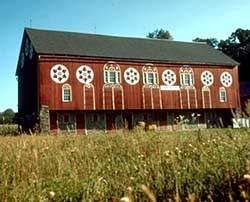If you’ve ever taken a drive through the countryside, especially in the United States, you’ve likely noticed a recurring feature of the landscape: red barns. These iconic structures dot the rural scenery, but have you ever wondered why barns are so often painted red? The answer is rooted in history, practicality, and even a bit of fashion.
Centuries ago, when farmers in Europe began protecting their barns with paint, they turned to readily available and affordable materials. Linseed oil, extracted from flax seeds, was a popular choice as a wood sealant. This tawny-colored oil was mixed with other ingredients like milk and lime to create a durable, quick-drying paint. Interestingly, pure linseed oil itself doesn’t impart the red color we associate with barns.
 Classic red barn in a rural American landscape, a common feature of the agricultural countryside.
Classic red barn in a rural American landscape, a common feature of the agricultural countryside.
The Evolution of “Barn Red”: From Burnt Orange to Chemical Pigments
Historically, the shade of “barn red” was quite different from the bright, fire-engine red often seen today. Early barn paint was more of a burnt-orange or muted red. The color came from additives mixed into the linseed oil base, and two primary theories explain the origin of this reddish hue.
One theory suggests that farmers would add blood from animal slaughters to the paint mixture. Blood contains iron oxide, which would impart a reddish tint and potentially act as a further sealant. Another, perhaps more practical, theory points to the use of ferrous oxide, more commonly known as rust. Rust was an easily accessible and inexpensive material. Mixing rust into the linseed oil paint not only provided a reddish-brown color but also acted as a natural fungicide, helping to protect the barn wood from mold and decay.
Regardless of the exact tinting method, red barns soon became a popular aesthetic choice. They offered a striking visual contrast against the typically white farmhouses, adding a touch of color to the rural landscape.
Red Barns in America: Tradition Meets Affordability
When European settlers arrived in America, they brought with them the tradition of building and painting barns red. This practice continued and evolved over time. By the mid to late 1800s, the reasons for red barns shifted slightly due to advancements in paint production.
As chemical pigments became more widely available, red paint surprisingly became the most affordable option. The pigments used to create red paint were cheaper to produce compared to other colors. This economic factor solidified red as the go-to color for barns across the United States. For farmers, painting barns red was not only a matter of tradition but also a practical and cost-effective choice.
From Red to White and Beyond: The Changing Colors of Barns
The reign of red barns as the dominant color eventually saw a challenge when whitewash became a more economical alternative. Whitewash, made from lime and water, was even cheaper than red paint. As a result, white barns began to appear, diversifying the color palette of farm buildings.
Today, while red remains a popular and traditional choice, barn colors can vary greatly. The color often depends on the barn’s purpose, the farmer’s personal preference, and even regional trends. However, the enduring image of the red barn remains deeply ingrained in the American agricultural landscape, a testament to its historical roots and practical origins.